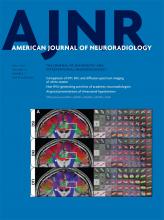Article Figures & Data
Tables
Criteria 1) Eligible patients between 30 and 80 years of age; intracranial arterial stenosis will not be considered if related to the following: nonatherosclerotic factors: arterial dissection, Moyamoya disease; vasculitic disease; herpes zoster, varicella zoster, or other viral vasculopathies; neurosyphilis; any other intracranial infection; any intracranial stenosis associated with CSF pleocytosis; radiation-induced vasculopathy; fibromuscular dysplasia; sickle cell disease; neurofibromatosis; benign angiopathy of the central nervous system; postpartum angiopathy; suspected vasospastic process; and suspected recanalized embolus 2) Symptomatic intracranial stenosis: presenting with TIA or stroke within the past 12 months attributed to 70%–99% stenosis of a major intracranial artery (internal carotid artery, MCA [M1], vertebral artery, or basilar artery) 3) Degree of stenosis: 70%–99% severity confirmed by catheter angiography for enrollment in the trial 4) Remote infarctions on MRI were acceptable, which could be accounted for by the occlusion of the terminal cortical branches or hemodynamic compromise (perforator strokes excluded); perforator strokes due to perforator occlusion are defined as basal ganglia or brain stem/thalamus infarction related with middle cerebral artery or basilar artery stenosis 5) Expected ability to deliver the stent to the lesion 6) All patients should be treated beyond a duration of 3 weeks from the latest ischemic symptom onset 7) No recent infarctions identified on MRI (indicated as high signals on DWI series) at enrollment 8) No massive cerebral infarction (more than one-half of the MCA territory), intracranial hemorrhage, epidural or subdural hemorrhage, and intracranial brain tumor on CT or MRI 9) mRS score of ≤2 10) Target vessel reference diameter must be measured at 2.00–4.50 mm; target area of stenosis is ≤14 mm in length 11) No childbearing potential or has a test negative for pregnancy within the week prior to study procedure; female patients had normal menses in the past 18 months 12) Patient is willing and able to return for all follow-up visits required by the protocol 13) Patients understand the purpose and requirements of the study and have signed an informed consent form - Table 2:
Demographic and clinical characteristics of the patients treated in the single-arm trial
Baseline Demographics Age (median) (IQR) 56.0 (49–63) Men (No.) (%) 73 (73%) Risk factors Hypertension (No.) (%) 61 (61%) Hyperlipidemia (No.) (%) 15 (16%) Diabetes mellitus (No.) (%) 25 (28%) History of cigarette smoking (No.) (%) 44 (44%) History of alcoholism (No.) (%) 28 (28%) Ischemic stroke as qualifying event (No.) (%) 50 (50%) NIHSS sores at admission (median) (IQR) 0 (0–1) mRS scores at admission (median) (IQR) 0 (0–1) Barthel Index at admission (median) (IQR) 100 (100–100) Angiographic characteristics Preprocedure: average degree of stenosis (%) 82.7 ± 8.9 Location Basilar artery 27 (27%) Intracranial internal carotid artery 17 (17%) Middle cerebral artery 38 (38%) Intradural vertebral artery 18 (18%) Postprocedure: average stenosis (%) 13.5 ± 10.2 Note:—IQR indicates interquartile range.












